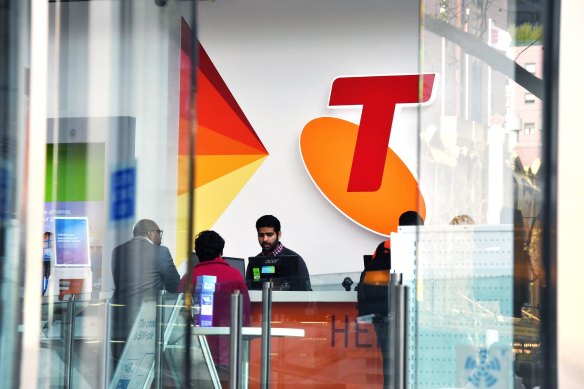
We reached the spending cliff – but the jobs cliff awaits
Save articles for later
Add articles to your saved list and come back to them any time.
Three major Australian companies, Telstra, Lend Lease and Ansell, announced significant job losses this week, but whether this is a harbinger for a move towards a jobs cliff will become clearer over the next month.
Normally during an economic slowdown, this would represent the tip of the iceberg – the start of a cascade of redundancies. But economic conventions and timelines have been disrupted, and even uprooted, in the post-COVID world.
Telstra is an early mover in cutting staff.Credit: Joe Armao
Convention is now challenged by a counter-trend – staff hoarding.
For 18 months, companies have desperately been trying to hire and retain employees, and the angst associated with labour shortages has been scarring. Many companies have felt the pain of staff shortages and the impact on earnings.
So, yes, the jobs cliff is ahead, but getting there is proving to be more a marathon than a sprint.
All three of the abovementioned companies had particular structural changes that triggered staff cuts, which explained why they have been more expeditious in shedding staff. That said, they were also motivated by a desire to cut costs.
Others will eventually follow.
History has demonstrated clearly that shedding staff is the quickest and most reliable way of taking out business cost.
History has demonstrated clearly that shedding staff is the quickest and most reliable way of taking out business cost. It is the go-to response when revenue is under pressure.
(Less than a year ago, the technology industry, including Google, Meta and Atlassian, was under performance pressure and responded with wholesale redundancies.)
Next month we’ll see the results of the 2023 profit season, which will measure the resilience of corporate earnings in the face of the slowing economy.
The first six months of this calendar year mark the start of companies feeling the early effects of the economic slowdown and the fall in consumer spending. Some in the discretionary retail sector have downgraded their forecasts.
But the current six months will deliver significantly more earnings pain. With revenue already under pressure for many companies, shareholders would normally expect them to outline measures to rein in costs to rescue profits.
Economists are in unison that at some point over the next six months unemployment should start rising. Conventionally, the already apparent slowdown in the economy would have triggered a move by companies to shed staff.
Each month most economists have been predicting at least a glimmer of softness in the labour market. (In much the same way economists and analysts predicted a consumer spending cliff well before it hit.)
Supermarket giant Coles is fielding 18 applicants for every job it advertises.Credit: Edwina Pickles
The June labour market data out on Thursday paints a clear picture that this hasn’t really started yet in earnest – unemployment remained sticky at 3.5 per cent.
The minutes from the Reserve Bank’s July meeting noted that: “A range of indicators suggested the tightness in the labour market had eased slightly and broader measures of underutilisation had increased a little from multi-decade lows in preceding months. Firms had also reported an improvement in labour availability in some sectors, though finding suitable labour remained more difficult than prior to the pandemic.”
According to a report this week in The Australian Financial Review, supermarket giant Coles is fielding 18 applicants for every job it advertises, and bosses say competition for roles in other industries is surging. The report said Westpac, Australia’s second-biggest bank with 39,000 full-time employees, also reported a surge in the number of applications per role, as well as a sharp fall in attrition rates.
This is a clear precursor to a softer labour market but not one that has turned.
Thus, the reluctance to shed staff presents as a dilemma for businesses that are already witnessing softer revenue and wanting to attack their cost bases. They may just bank the cost improvements as inflation in input prices has improved or even reversed.
But as the year progresses the pressure to cut staff will intensify.
The Business Briefing newsletter delivers major stories, exclusive coverage and expert opinion. Sign up to get it every weekday morning.
Most Viewed in Business
From our partners
Source: Read Full Article

